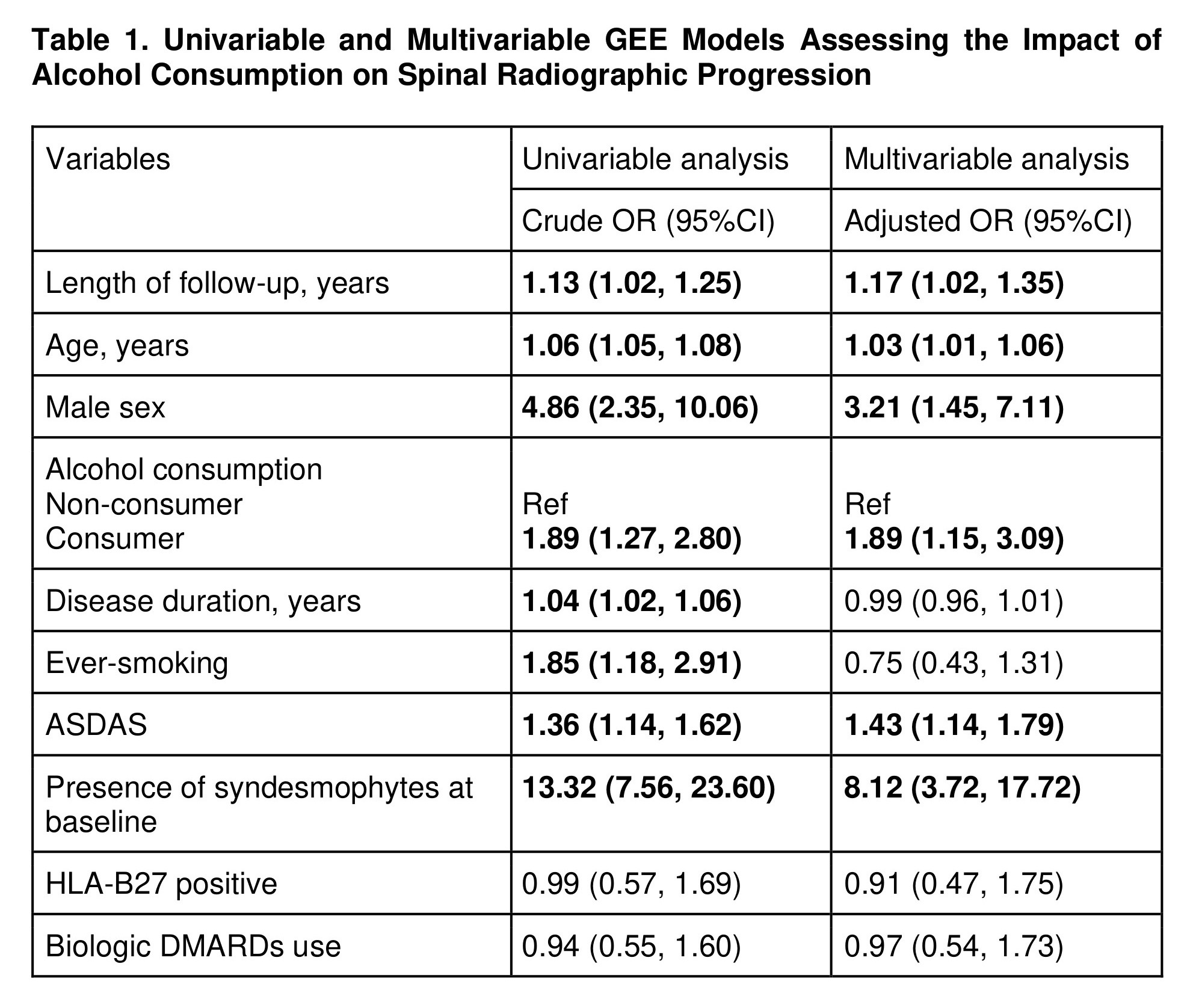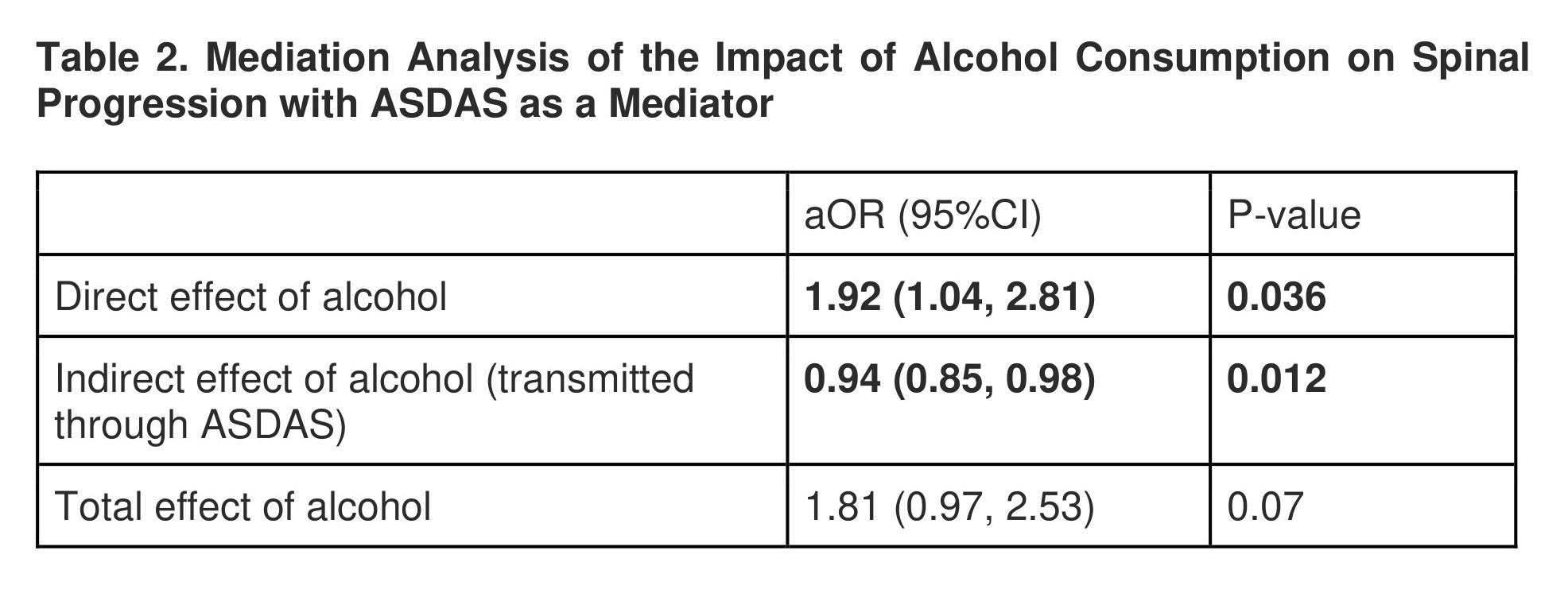Session Information
Date: Saturday, November 16, 2024
Title: Abstracts: SpA Including PsA – Diagnosis, Manifestations, & Outcomes I
Session Type: Abstract Session
Session Time: 1:00PM-2:30PM
Background/Purpose: We assessed whether alcohol consumption (AC) is associated with spinal radiographic progression in axSpA as measured by the modified Stoke Ankylosing Spondylitis Spinal Score (mSASSS). Progression was defined as an increase of ≥2 mSASSS units in 2 years. In addition, we evaluated to what extent this association is mediated through Ankylosing Spondylitis Disease Activity Score (ASDAS).
Methods: We used the data from the University Health Network (UHN)- Spondyloarthritis cohort, which followed axSpA patients over 6 years. We included axSpA patients with available data on alcohol consumption and spinal radiographs every 2 years. Generalized estimating equation (GEE) analyses were conducted to determine the association between AC and spinal progression, utilizing repeated measures of alcohol over time. Sensitivity analyses were performed to assess the impact of sex and disease subgroup. Mediation analysis were performed to test whether the effect of alcohol consumption on spinal progression in axSpA patients operates through ASDAS. Linear imputation methods were utilized to address missingness.
Results: GEE analyses were performed in 769 records of radiographic intervals from 387 patients (70% male, 84% radiographic-axSpA (r-axSpA), mean (±SD) age 38.6 ±13.0 years). Patients reported consuming alcohol ( > 0 units/week) in 47% of radiographic interval records analyzed. The multivariable GEE model revealed increased odds of spinal progression in consumers, adjusted for important confounders (Table 1). In the adjusted analysis, length of follow-up, ASDAS, syndesmophytes at baseline, male sex, and age were also associated with increased odds of spinal progression. Subgroup analysis showed a significant association between alcohol and spinal progression only in males and patients with r-axSpA (OR 2.28, 95%CI 1.31 to 3.96 and OR 1.90, 95%CI 1.15 to 3.15, respectively). Using mediation analysis, we demonstrated a significant direct effect of alcohol on spinal progression, suggesting heightened spinal damage progression in consumers (Table 2). The indirect effect of alcohol via ASDAS was negatively associated with spinal progression, as consumers had lower ASDAS and, thereby, lower odds of spinal progression. The total effect showed only a trend toward increased odds of progression.
Conclusion: These findings highlight the detrimental effect of alcohol on spinal progression in axSpA, especially in males and r-axSpA patients. The exact mechanism underlying alcohol’s effect on spinal progression remains unclear. Our mediation analysis failed to show that inflammation and symptoms driven by inflammation play a role in this relationship. Future studies assessing alcohol’s effect on spinal structural damage in axSpA should explore other biological mechanisms beyond inflammation.
ASDAS: Ankylosing Spondylitis Disease Activity Score; bDMARD: biologic disease-modifying antirheumatic drug; aOR: adjusted Odds Ratio; Ref: reference.
To cite this abstract in AMA style:
Gendron E, Maguire S, Deng Y, Haroon N, Inman R. Investigating the Association Between Alcohol Consumption and Spinal Radiographic Progression in Axial Spondyloarthritis: A Longitudinal Cohort Analysis over a Period of 6 Years [abstract]. Arthritis Rheumatol. 2024; 76 (suppl 9). https://acrabstracts.org/abstract/investigating-the-association-between-alcohol-consumption-and-spinal-radiographic-progression-in-axial-spondyloarthritis-a-longitudinal-cohort-analysis-over-a-period-of-6-years/. Accessed .« Back to ACR Convergence 2024
ACR Meeting Abstracts - https://acrabstracts.org/abstract/investigating-the-association-between-alcohol-consumption-and-spinal-radiographic-progression-in-axial-spondyloarthritis-a-longitudinal-cohort-analysis-over-a-period-of-6-years/


